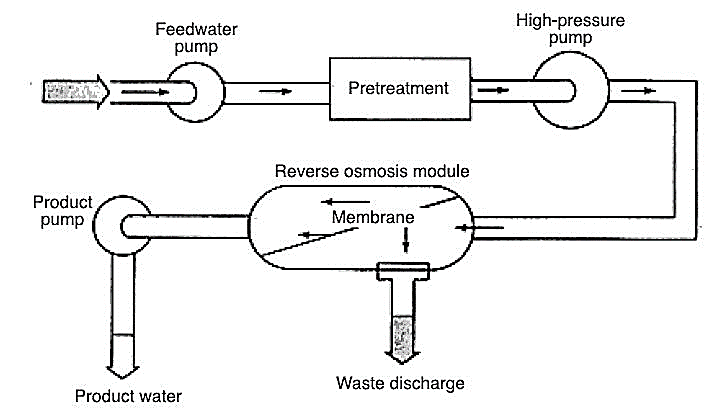
Seawater Desalination with Reverse Osmosis Plant
All Reverse Osmosis crops are generally Desalination Crops but desalination is getting referred to sea h2o normally.As sea drinking water has incredibly higher TDS calls for pretty higher strain to pressure sea h2o as a result of membranes which can be unique then brackish h2o membranes.
Reverse Osmosis Plant Details:
A reverse osmosis plant is really a production plant, the place drinking water is purified and desalinated by forcing drinking water by way of a membrane, generally often known as a reverse osmosis system. H2o made by plant RO can be useful for various applications like desalination, wastewater procedure, and the reclamation of dissolved minerals.
RO Plant Description
A mean ingesting drinking water RO plant program needs six KW several hours of energy to desalinate just one cubic meter of drinking water. Reverse osmosis water crops involves a range of pre-treatment method tactics which includes softening, DE chlorination, and anti-scale therapy. Following pre-cure, substantial levels of force ship water by way of a semi-permeable membrane, which holds all contaminants other than water.
RO Plant Structure
To reinforce the efficiency and life of the Reverse Osmosis plant, effective pretreatment with the feed water is necessary. Collection of the right pretreatment will optimize performance and membrane daily life by reducing:
Fouling
Scaling
Membrane Degradation
RO plant style and design is consisting of:
Figuring out pretreatment prerequisite of Reverse Osmosis Plant
When the feed drinking water has traces of major metals, it is highly encouraged to dose some chlorine to alter the dissolved large metals to Bodily variety, the media filter will filter nearly all of it inside of a ro water purifier plant.
Reverse Osmosis Plant Collection of membrane
Membrane features are an essential Section of RO crops. The proteins (mostly polyamide) that makeup membrane components fluctuate depending on the ending clarity and intake water seawater or brackish water and so on
Waterman engineers Australia RO plant for seawater desalination
Waterman Engineers in Australia has made a Reverse Osmosis (RO) plant for seawater desalination, which presents several benefits above other desalination approaches. Here are several critical advantages of their RO plant:
Electricity Performance:
As compared to other desalination techniques like thermal distillation, RO requires less energy. Waterman Engineers' RO plant makes use of Highly developed membrane technology, allowing it to work at lower pressures and minimize General Power use.
Environmental Impression:
RO generates considerably less brine discharge when compared with thermal strategies, decreasing the influence on marine ecosystems. This aligns with Australia's focus on environmental sustainability and conservation.
Large Drinking water Purity:
The RO process proficiently removes salts, minerals, and impurities, manufacturing large-quality freshwater that fulfills stringent ingesting drinking water standards. This dependability is crucial for delivering safe and cleanse water to communities.
Modular Layout:
Waterman Engineers' RO plant employs a modular design, making it possible for for scalability and adaptability. This is particularly beneficial for spots with varying drinking water calls for, as modules can be additional or modified appropriately.
Lessened Footprint:
RO plants typically Use a smaller physical footprint when compared with thermal desalination crops, which frequently require substantial infrastructure for heating and cooling processes.
Speedy Get started-Up and Shutdown:
RO crops can be began and stopped reasonably promptly, allowing for for improved responsiveness to changing water requires and emergencies.
Lower Chemical Use:
Unlike some other desalination methods, RO demands fewer substances for Procedure and cleaning, minimizing chemical-related environmental concerns.
Regularity in Effectiveness:
The RO course of action is a lot less sensitive to feedwater high quality fluctuations than other methods, making sure a far more constant overall performance over time.
Price tag-Performance:
Although initial financial investment charges could be significant, RO vegetation tend to possess reduce operational and servicing expenses Ultimately when compared with thermal techniques.
Reverse Osmosis (RO) is usually a water purification course of action that utilizes a partly permeable membrane to eliminate ions, undesirable molecules, and bigger particles from ingesting water. By making use of force to beat osmotic stress, it lets the passage of water molecules although rejecting contaminants, thus producing clear drinking water on a person side in the membrane and concentrated impurities on the opposite.
The working principle of a Reverse Osmosis (RO) plant includes making use of tension to a saline Answer to power drinking water molecules by way of a semi-permeable membrane. This membrane lets only h2o to go though rejecting salts, contaminants, and impurities, causing purified h2o on the permeate side along with a concentrated Remedy of contaminants within the brine aspect.
The benefits of Reverse Osmosis contain making substantial-good quality, cleanse drinking water by eliminating contaminants, getting productive and cost-effective as time passes, demanding negligible chemical use, and staying adaptable to varied scales of operation from compact dwelling Desalination Plant Manufacturer devices to massive municipal plants.
RO crops have replaced Demineralisation (DM) plants mainly because they generally supply a much more economical and value-efficient solution for drinking water purification. RO methods You should not have to have the regeneration chemical substances that resin-centered DM vegetation do and will get rid of a broader range of contaminants, which include dissolved solids and microorganisms.
Waterman Engineers Australia probably uses Reverse Osmosis (RO) vegetation for seawater desalination by forcing seawater via a semi-permeable membrane to remove salt together with other impurities. This process generates fresh, potable drinking water within the ocean, addressing water scarcity and delivering a sustainable source for different requires.